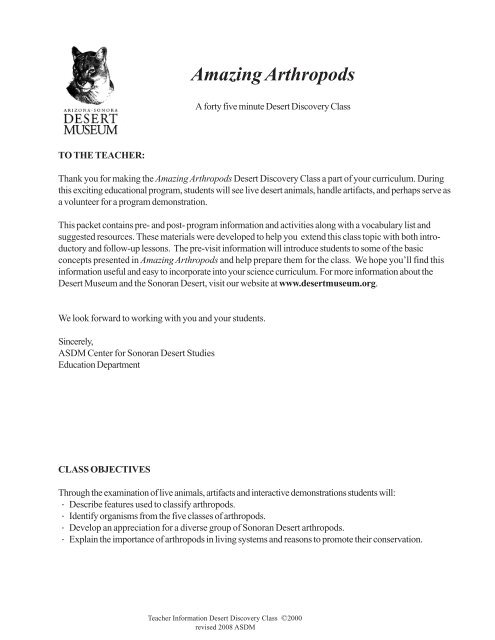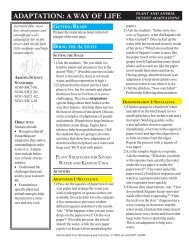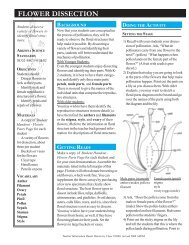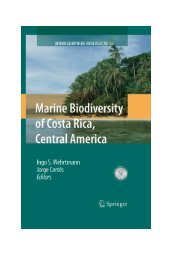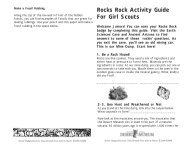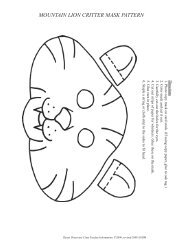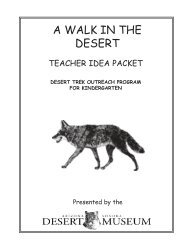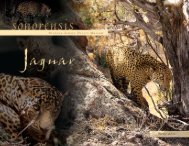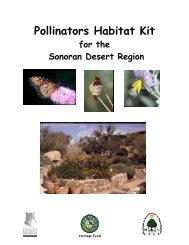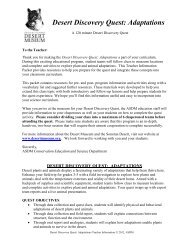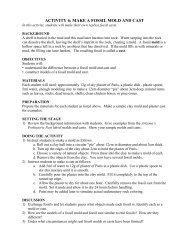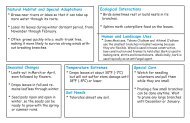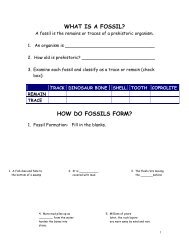Amazing Arthropods - Arizona-Sonora Desert Museum
Amazing Arthropods - Arizona-Sonora Desert Museum
Amazing Arthropods - Arizona-Sonora Desert Museum
You also want an ePaper? Increase the reach of your titles
YUMPU automatically turns print PDFs into web optimized ePapers that Google loves.
RESOURCESActivities:· Braus, J., ed. Ranger Rick’s NatureScope: Incredible Insects. Washington D.C.: National Wildlife Federation, 1984, 1989. (For ordering information call:1-800-722-4726)· Council for Environmental Education. Project WILD Elementary Activity Guide. U.S.A.,1983, 1985, pp. 197-200.· Hinman, Laurie A. “What’s the Buzz? A classroom simulation teaches students about life in the hive.”Science and Children. February, 2000.· Lazaroff, David W., editor. Dr. Strangeplant. Tucson: Tucson Audubon Society. 1991.· Pascoe, Elaine. Crickets and Grasshoppers. Woodbridge, CT: Blackbirch Press. 1999.· Roche, Robin K. Dyeing with Cochineal. Tucson, 1997.On-line Curriculum and Information:· <strong>Desert</strong> USA: www.desertusa.com/animal.html This site contains information on many desert animals, includingarthropods.· Mosquito Site. http://www.desert-mosquito.org/ Developed by a graduate student in Agriculture at theUniversity of <strong>Arizona</strong>, this site provides information on mosquitos in our region for teachers and children. It alsoprovides links to a wide range of entomology curricula for grades K-12, as well as general entomology sites forkids.· Using Live Insects in Elementary Classrooms for Early Lessons in Life. http://insected.arizona.eduDeveloped by the Center for Insect Science Education Office at the University of <strong>Arizona</strong>, this curriculum is aprogram dedicated to introducing health topics to children in kindergarten through third grade. The result is aprintable collection of twenty integrated lessons with science and math activities that use live insects. Thelessons are aligned with National Science Education Standards. Also available in hard copy.Organizations:· <strong>Arizona</strong>-<strong>Sonora</strong> <strong>Desert</strong> <strong>Museum</strong>: 2021 N. Kinney Rd., Tucson, AZ 85743. Phone: (520) 883-3025.www.desertmuseum.org [Visit our arthropod display in the Reptile Room. Many of our docent interpretationson grounds involve live arthropods and their products.]· Project WILD: Contact Sandy Reith, Project WILD Coordinator, <strong>Arizona</strong> Game & Fish Department, 2221West Greenway, Phoenix, AZ 85023, (602) 789-3243 for more information on Project WILD in the state.· <strong>Sonora</strong>n Arthropod Studies Institute (SASI): P.O. Box 5624, Tucson, AZ 85703. (520) 883-3945. http://www.sasionline.org/ SASI is a non-profit environmental and science education organization that studies andinterprets the vital roles arthropods play in the <strong>Sonora</strong>n <strong>Desert</strong>. They offer a variety of outreach programs (K-5), teacher resources, and two publications, Backyard BUGwatching and the instar.Supplies:· Ant Colonies available occasionally to Tucson area teachers to raise in classrooms. Contact DianaWheeler at (520) 621-3273 for more information.· Local pet stores and bait stores (crickets, mealworm larvae)· ARBICO (<strong>Arizona</strong> Biological Control, Inc.) P.O. Box 4247 CRB, Tucson, AZ 85738 (800)825-9785. (ladybird beetles - larvae and adults - and praying mantid egg cases)· Carolina Biological Supply Company, Biology/Science Materials, Burlington, NC, 27215. (800)334-5551. (ants, crickets - nymphs and adults, isopods, ladybird beetles, mealworm larvae,milkweed bugs - eggs and adults, mosquitos, praying mantid egg cases, silkworm eggs)· University of <strong>Arizona</strong> Entomology Collection. Loans of specimens, curriculum information,occasional speakers. Contact Carl Olson at (520) 621-5925 for more information.Teacher Information <strong>Desert</strong> Discovery Class ©2000revised 2008 ASDM
VOCABULARYAbdomen - The last body region of an insect. It contains most of the internal organs.Antennae - A pair of sensory organs on the head of an insect used for taste, smell, touch, and communication.Arachnid - An arthropod with no wings, no antennae, one or two body segments, and eight legs.Arthropod - An animal with jointed legs, an exoskeleton, and a segmented body.Centipede - An arthropod with no wings, one pair of antennae, and a flat body with many segments and apair of legs attached to each segment.Chrysalis - The pupal case of many butterflies.Cocoon - The pupal case of many moths, made out of silk.Colony - A group of individuals with common characteristics.Complete metamorphosis - The process of change in advanced insects from egg to larva to pupa to adult.Crustacean - An arthropod with no wings, two pairs of antennae, two body segments, and ten or morelegs.Decomposer - An organism that breaks down dead plant and animal materials into their chemical componentsthrough the process of decay. Examples: mushrooms and other fungi, millipedes.Exoskeleton - The hard outer skeleton of an arthropod that protects and supports the internal organs,muscles, and other tissues.Food chain - A group of plants and animals in a natural community through which energy flows in the formof food.Incomplete metamorphosis - Also known as “simple” metamorphosis. The insect goes through three lifestages: egg to nymph to adult.Insect - An arthropod that has one or two pairs of wings, one pair of antennae, three body segments, andthree pairs of legs.Larva - (plural larvae) The immature stage of an insect that undergoes complete metamorphosis. Larvaeare quite different from adults, i.e. caterpillars are the larvae of moths and butterflies and maggots are flylarvae.Metamorphosis - The process of changing from egg to adult.Millipede - An arthropod with no wings, one pair of antennae, a round body with many body segments,and two pairs of legs on each segment.Molt - To shed the exoskeleton or outer skin.Nymph - The immature form of an insect that undergoes incomplete metamorphosis. Nymphs are similar toadults in diet and behavior but are sexually immature, wingless, and smaller.Pesticides - Chemicals used to kill insects.Pollinate - To spread pollen from the male parts to the female parts of a flower, resulting in the productionof seeds and fruits.Pupa - The inactive stage of an insect undergoing complete metamorphosis in which a larva changes into anadult.Thorax - The middle of the three body parts of an insect to which the legs and wings are attached.PROGRAM INFORMATION AND ACTIVITIESAMAZING ARTHROPODSThis activity introduces students to the characteristics, diversity, adaptations, and important roles of some<strong>Sonora</strong>n <strong>Desert</strong> arthropods.UNIDENTIFIED (FLYING?) ARTHROPODSStudents identify the features that distinguish the five different classes of arthropods and observe arthropodpictures or specimens to determine the class to which they belong.Teacher Information <strong>Desert</strong> Discovery Class ©2000revised 2008 ASDM


